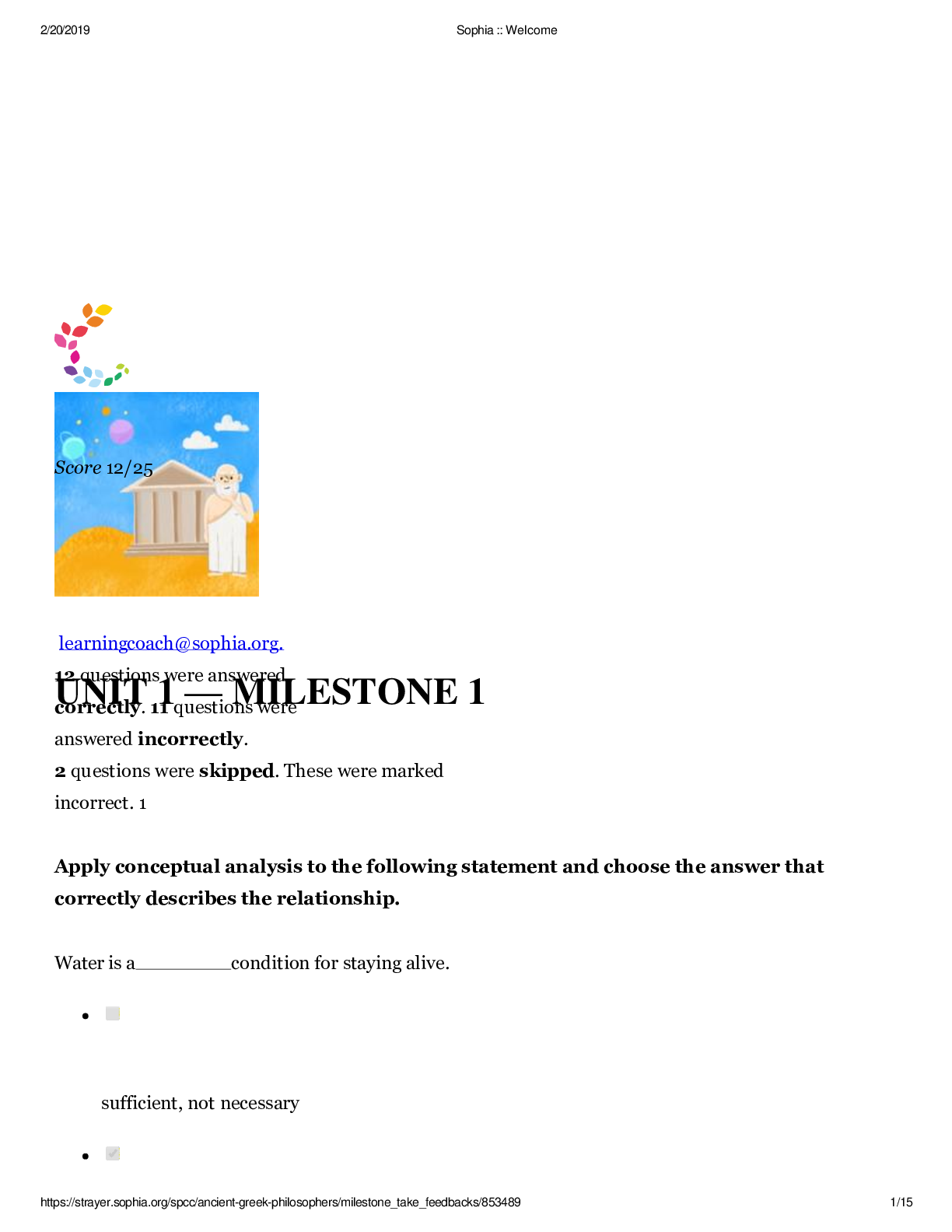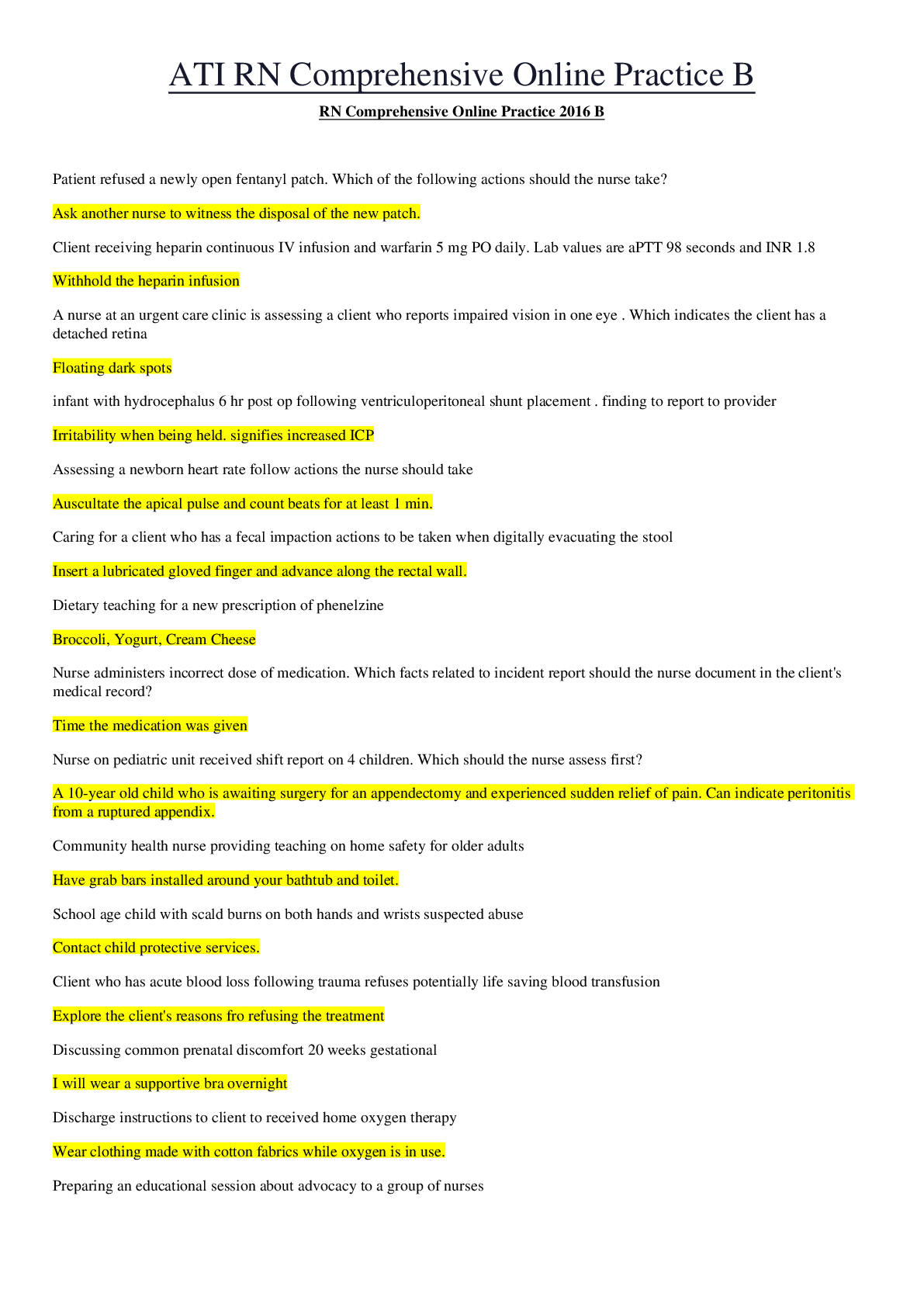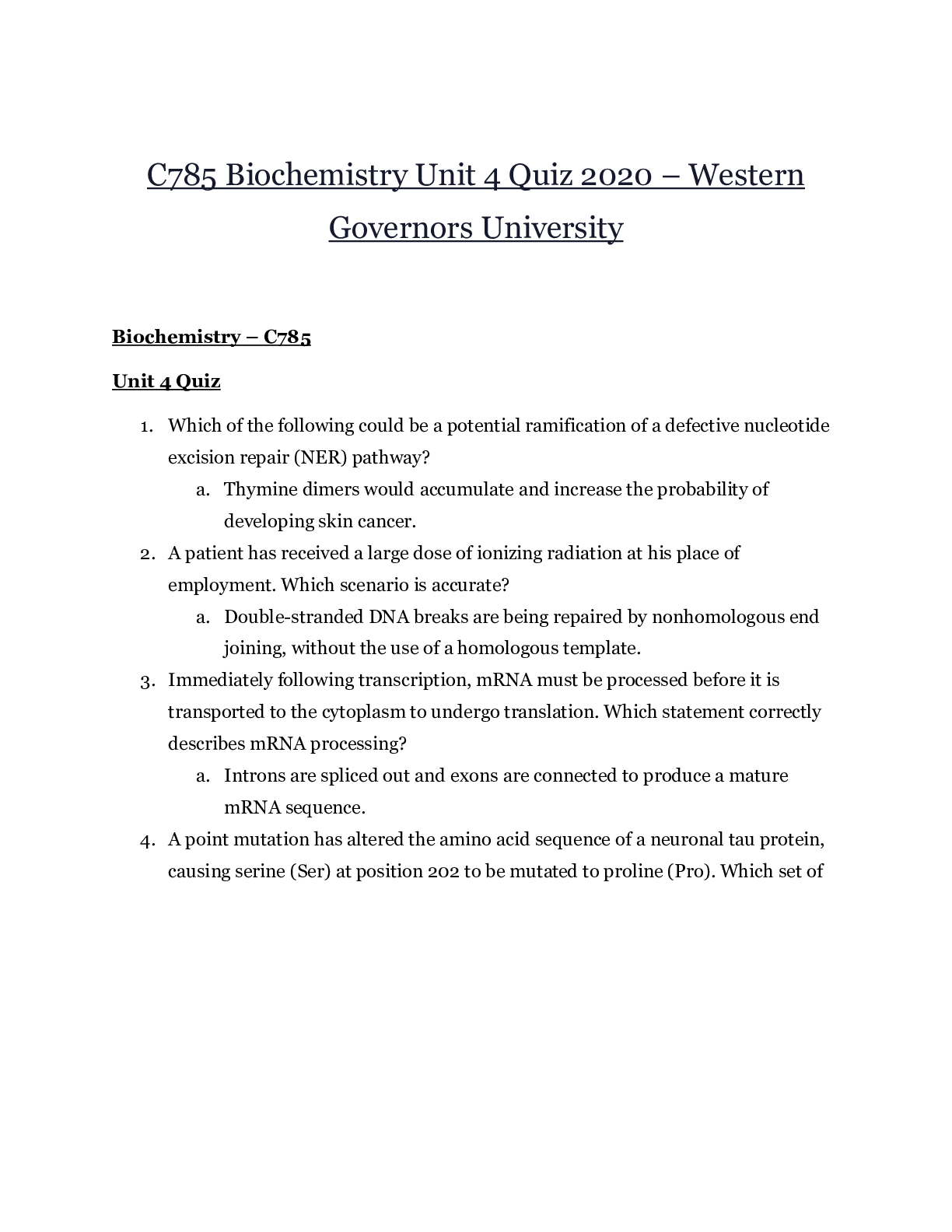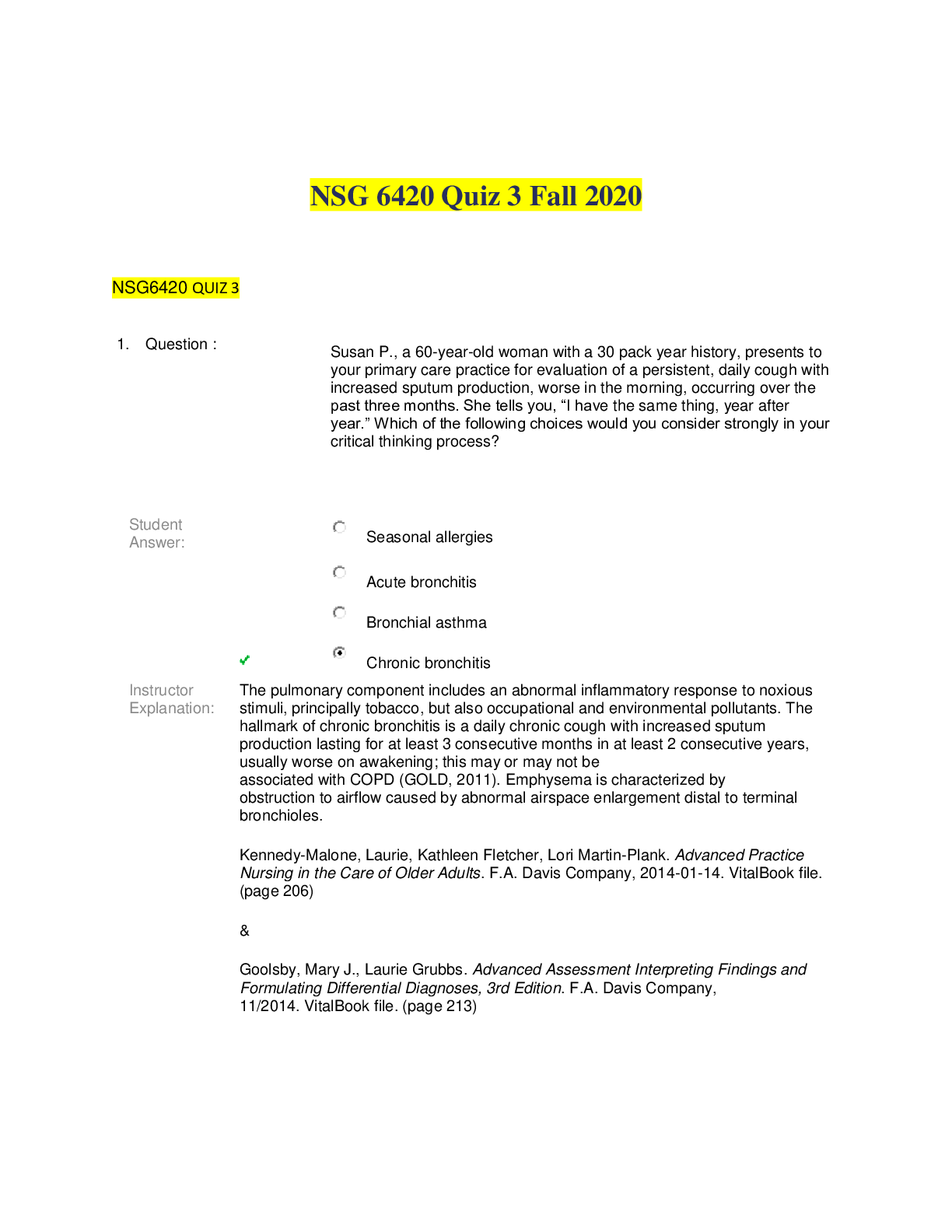BioChemistry > EXAM > C785 Biochemistry Review Module 1 2020 | Biochemistry Review Module 1 2020 – Graded A (All)
C785 Biochemistry Review Module 1 2020 | Biochemistry Review Module 1 2020 – Graded A
Document Content and Description Below
C785 Biochemistry Review Module 1 2020 – Western Governors University Biochemistry Review Module 1 DNA- 1. Located in nucleus 2. Double helix 3. Nucleic acid 4. Adenine/Guanine/Cytosine/Thymi... ne 5. A-T/C-G pairing 6. Duplicates itself and passes on to generation to generation 7. Contains 46 chromosomes (23 pairs from mother and father) 8. Stores and transmits-chemicals and traits RNA- 1. Carries important info from DNA to the body (Transcription) 2. Used to make proteins (Translation) 3. Single stranded 4. 3 types of RNA (mRNA- messenger contains codons, rRNA-ribosomal contains 2 subunits and tRNA- transfer amino acid with end codon) 5. mRNA- Adenine/Guanine/Cytosine/Uracil 6. A-U/C-G pairing Central Dogma- replication of DNA process= DNA- transcription- RNA- translationProtein Steps of DNA replication- 1. DNA must be separated 2. New DNA synthesized by a protein called DNA polymerase• DNA polymerase takes the individual nucleotides and matches them up to the parental sequences to ensure a correct pair. • DNA polymerase does not start synthesis of a new strand, it must bind with a RNA primer • RNA primer is synthesized by RNA polymerase Genes- encoded with information/ small segment of DNA 1. Gene Expression- the ability to turn genes on and off 2. Epigenetics- packaging of DNA: DNA wrapped around histones to make nucleosomes • Wide spread nucleosomes=genes ON (i.e. a dance floor-more space you can get your dance ON) • Tightly packed nucleosomes = genes OFF • Environment can change genetics in generations Genetic sequence- 5’(phosphate)- 3’ (sugar) Non-Complementary Template Strand: non-coding Coding Strand: non-template Coding Strand: mRNA (identical) Non-Template Stand: mRNA Complementary Template Strand: non-template strand mRNA: tRNA/non-coding strand:mRNA Ex: 5’ ATG AGT CTC TCT 3’ Template strand: 3’ TAC TCA GAG AGA 5’ mRNA sequence: 5’ AUG AGU CUC UCU 3’ Protein Sequence- 1. Used in mRNA form only from 5’ – 3’ for the chart 2. Mutations are found from the protein sequence Splicing- introns are cut out and the remainging exons are joined togetherProtein MutationsPOINT MUTATIONS 1. Nonsense- change in 1 nucleotide produces a STOP (found on the mRNA amino acid chart) 2. Silent- Change in 1 nucleotide but does not change amino acid 3. Missense- Change in 1 nucleotide leads to coding a new amino acid DOUBLE STRANDED BREAKS 1. Environmental (i.e. x-rays) discontinuity through both strands (double strand break) FRAMESHIFT MUTATIONS- nucleotide-codon pattern gets “out of sync “ 1. Insertion- changes in the amino acid and can lead to formation of STOP (chain can be longer) 2. Deletion- deletion of nucleotide (chain is shorter) #’s not divisible by 3 (ATG CGC CG) Mutation Repairs- 1. Base excision repair (BER): Chemical damage to a single nucleotide. The single nucleotide is removed (excised) by enzymes and replaced by DNA polymerase. Example of damage: Rogue oxygen attaches to a nucleotide; this is what antioxidants try to protect us from. Eat your blueberries! 2. Nucleotide excision repair (NER): Chemical or radiation damage to two or more nucleotides. A large section of nucleotides is removed, including the damage and nucleotides around it, and replaced by DNA polymerase. Example of damage: UV radiation causes two thymines (T’s) to clump together. These are called thymine-thymine (T-T) dimers. 3. Mismatch repair (MMR): During replication, DNA polymerase can usually proofread to make sure it has the made the correct match, but sometimes a mismatch still gets through. When this happens, mismatch repair removes alarge section of nucleotides, including the mismatch, from the newly replicated DNA, and then DNA polymerase tries again. Example of damage: A C is put across from T instead of A. 4. Homologous recombination (HR): This is one of two types of repair for doublestrand breaks (DNA is literally cut in half). The break is repaired by using the replicated copy of the DNA (the homologous DNA) to “recombine” with the broken copy so that the DNA is copied back correctly. Example of damage: Cosmic radiation can cause double-strand breaks in astronaut’s DNA. 5. Non-homologous end-joining (NHEJ): This is the second type of repair for double-strand breaks. If a break occurs before the DNA is replicated, the break is pasted back together instead. Because the break can be uneven, nucleotides may be removed (deleted) to make the ends even so they can be stuck together. A deletion can result in a frameshift mutation, but that is a risk our cells are willing to take because the damage from a break is a lot worse. Inheritance- Genotype- pair of genes Phenotype- physical characteristics Inheritance patterns- Using Punnett Square 1. Complete Dominance- 3/4 (i.e black and white puppies make 3 black puppies and 1 white) 2. Incomplete Dominance- grey area (i.e. black and white puppies makes grey puppy) 3. Co-Dominance- 2/2 (i.e. black and white puppies make 2 black puppies and 2 white puppies) 4. Sex-Linked- X-linked traits-largely in males Pedigree- 1. Carrier parents- Recessive trait (2 parents unaffected with affected offspring) 2. Autosomal - Males and females equally affected 3. Sex-Linked- Males affected >females affected 4. Non-carrier parents- Dominate trait- - - - -- - - - - - - - - - - - - - - - - Lipid Bilayer- Contains fluid mosaic Fatty acid- leaky membrane (has spaces) Triglycerides-leaky membrane Phospholipids- tight pack-impermeable membrane4. Cholesterol- Made of 4 rings (3 Hexagon + 1 Pentagon) • Sterols- Cholesterol, Cortisol, and Testosterone • Key role: expands range of membranes fluid at various temps “antifreeze” • Increase temp to solidify/ Decrease temp to fall apart • Shorter length of cholesterol chain with double bonds = greatest membrane fluidity Eicosanoids- arachidonic acid- 20 carbon fatty acid (polyunsaturated- Omega 6 fatty acid) • Aids with inflammation, fever, immunity, and blood coagulationEssential fatty acids are required in the diet (found in meals) Fat Soluble VitaminsVitamin D- 2 Hexagon + 1 Pentagon derived from cholesterol (bone formation / disease: Rickets) Vitamin A- needed for vision / deficiency: night blindness Vitamin E- antioxidant (aid: protects cell membranes health / deficiency: various) Vitamin K- blood coagulation / deficiency: bleeding disorders Diabetic Ketoacidosis (DKA)- caused by a reduction in citric acid cycle intermediates, which decreases the amount of oxaloacetate that Acetyl COA can combine with to enter the citric acid cycle. • body is making ketones and BS high, ketones build up = ketoacidosis • Increased beta oxidation of fatty acids in absence of insulin signaling • Diet and disease can result in ketosis or DKA • Ketoacidosis- insufficient or absent insulin Ketone Bodies- Acetyl COA from beta oxidation converts to ketone bodies to help fuel the brain.Beta Oxidation- • Located in the Mitochondria • Occurs more in fasting state • Fatty acid attached to Acetyl COA = fatty acyl COA • Molecules produced ATP, NADH, FADH2 # Carbon atoms/2 (to find the # of Acetyl COA per fatty acid) # Carbon atoms/2-1 (to find the # of rounds of beta oxidation) Ex: 16 carbons/2 = 8 (Acetyl COA) – 1 = 7 rounds of beta oxidation Approximately 14 ATP produced each round = 7 rounds x 14 = 108 ATP Disease of Fatty Acid Metabolism (beta oxidation)- defect in the enzyme medium-chain (4-12 carbons) Acetyl- COA dehydrogenase• catalyzes the 1st step of beta oxidation for medium chain fatty acids • MCADD • Can be fatal • Must avoid fasting/ eat diets rich in slow-release carbs (complex carbs)/ avoid fats [Show More]
Last updated: 2 years ago
Preview 1 out of 25 pages

Buy this document to get the full access instantly
Instant Download Access after purchase
Buy NowInstant download
We Accept:

Reviews( 0 )
$14.00
Can't find what you want? Try our AI powered Search
Document information
Connected school, study & course
About the document
Uploaded On
Feb 20, 2021
Number of pages
25
Written in
Additional information
This document has been written for:
Uploaded
Feb 20, 2021
Downloads
0
Views
57








 – University of the People.png)








.png)

.png)


